Entries in Wind farm construction (20)
3/15/12 Farmers seeing the truth about wind developers:The lunch was free, but the contract you signed afterwards tied your land up for 50 years
From Five Questions to Ask Before Signing a Wind-Energy Lease
Source: Corn and Soybean Digest
March 15, 2012
1. How will the lease affect my farming operation?
A commercial wind project needs about 60 acres of land per megawatt (MW). But only 3% of that area — roughly three acres — is occupied by turbines, substations and access roads. The rest is a buffer zone to preserve wind flow. The lease should clearly state your rights to use the land for farming, grazing, development of subsurface minerals, hunting or other uses, Jambor-Delgado says.
Despite a relatively small footprint, a wind project can significantly affect farm operations, efficiency and production, says Dwight Aakre, North Dakota State University Extension farm management specialist.
Turbines and access roads can change field configurations, disrupting row orientation and creating inconvenient end rows or land fragments inaccessible to large equipment.
Field-drainage patterns may be altered. Center-pivot irrigation systems can be blocked. On grazing land, fences, gates and cattle guards may have to be changed.
“Aerial crop spraying is often an issue,” Aakre says. In the north, snow plowing can cause headaches for growers. “Those access roads have to be kept open, and if the snow piles up in the field it can take a long time to melt in the spring, delaying or preventing planting.”
Farmers should raise agricultural-production issues in the initial contract talks, says Dean Retherford of Halderman Farm Management, Lafayette, IN. Retherford has helped negotiate leases for several wind projects in northwest and west-central Indiana, involving 39 wind turbines on farms he manages.
“We learned to request input on the location of roads,” Retherford says. “And the wind companies found that landowners were more of a help than a hindrance” in site decisions, he says.
The lease should clearly state how you will be compensated if land is taken out of production or crops, livestock, soil or other property are damaged during construction or operation. On one of the farms Retherford manages, for instance, a crane crushed half a mile of brand new 12-in. tile.
2. How long will the lease tie up my land?
Wind-power leases often last 50 years. The long lease period is necessary to give the developer time to earn a return on the huge up-front investment needed to build a wind farm.
The initial lease term is usually 25 years — the expected life of a turbine. Wind-power leases also include a renewal provision, extending the contract for another 20 or 25 years. The decision on whether to renew the lease is almost always the tenant’s exclusively, Ferrell says. “Landowners don’t have any say.” However, some leases may allow landowners to renegotiate the commercial terms at renewal time. “This is where collective bargaining is a very helpful tool.”
Wind leases will probably affect your estate plans, too, he adds, so it’s a good idea to include your heirs in the discussions.
3. What are my obligations under the lease?
The lease will prohibit you from doing anything that obstructs the flow of wind over the surface of your property.
This includes restrictions on the height and location of structures such as barns, grain bins, cell towers, even houses and trees. In some cases, Ferrell says, the lease may prevent you from improving your property without permission from the wind company. “If you have improvements planned for the property, get approval for them” before you sign the lease, he says.
That goes for drainage upgrades, too, says Retherford, the Indiana farm manager. Wind farms often include underground power lines. “If you’re thinking of installing pattern tile in the next 10 years or so, do it before the turbines come.” After the project is built, you will need advance permission to maintain or repair tile, he adds.
You must also avoid damaging the wind-power structures. Vehicular accidents, fires or other mishaps can result in big losses, which may not be covered by your personal and farm-liability policies, Aakre says.
You will probably need to buy additional insurance to satisfy your indemnification obligations, Ferrell says. “This is especially important if you lease the property to hunters.” He adds: Increased insurance requirements for the landowner should be factored into compensation negotiations.
Likewise, the developer should indemnify you from damage claims arising from the tenant’s use of your land, Jambor-Delgado says.
Wind-power leases may also affect your obligations under other land agreements, she says. If the property has a mortgage, for example, you may need your lender’s consent to enter into a wind-company lease.
The lease should address the payment of debts secured by the land as well as placement of new liens on the property, she says.
Be wary of lease provisions that require you to personally obtain subordination agreements from your creditors, or that prevent you from using your land to secure future credit, Ferrell says.
A wind lease may also affect your eligibility for government farm programs, Jambor-Delgado says, so don’t sign a lease before checking with the appropriate agencies.
4. How will I be compensated?
Lease payments can be structured in many ways, including:
•fixed payments based on acreage, towers or megawatt capacity;
•royalty payments based on a percent of gross revenue;
•or some combination.
All the wind-lease payments that Dean Retherfordhas negotiated are based on gross revenue per turbine. Each 1.5- or 3-MW turbine earns an annual royalty payment of $5,000 and $8,000, he says. The wind companies pay property taxes on the commercial facility, but not on the leased land.
Most wind-power leases today provide for similar royalties based on revenue, Ferrell says — typically 3-5% of gross earnings. The contract should clearly spell out how your payment will be calculated.
For example, if your royalty is 4% of gross revenue, how will gross revenue be defined? Does it include only the sale of electricity, or does it also include revenue from the sale of tax credits or renewable energy credits? Will your payment be based on revenue from the turbines on your land alone, or on average revenue for the entire wind farm? What can be subtracted from gross revenue? Can the wind-power company deduct for power lost during transmission or for periodic curtailments?
Leases that include a royalty should also set a minimum rent that will be paid whether or not the turbines are generating power for sale, Ferrell says. In addition, many royalty leases now include an “escalator” provision raising the royalty percentage at specified intervals. This arrangement can be a good deal for both the developer and the landowner, he says. During the early years of the project, the company can recover its initial costs faster. In later years, the landowner shares in a greater percentage of profits.
Royalty leases should always include an audit provision, Aakre says, which allows access to the company’s financial records “to verify the revenues produced by the wind farm.”
5. What happens when the project ends?
“A frequent fear of landowners is that the developer will default or dissolve, and the landowner will be left with huge, inoperable machines” littering the property, Ferrell says.
Such fears are not unfounded, Aakre says. “It’s a real risk.” North Dakota’s relatively weak reclamation law, for example, “permits turbines to stand idle so long that the company could be long gone.”
Your lease should provide for the removal of the wind farm structures and roads when the project is finished and restoration of the soils, Aakre says. The lease should outline your rights if the wind company doesn’t fulfill its obligation. Some agreements require a performance bond from the developer to ensure that money is available to pay for decommissioning.
Land reclamation is one of the most difficult parts of a wind-power lease negotiation, Retherford says. Although the towers have significant metal salvage value, they require specialized cranes to dismantle. And the massive foundations are expensive to remove.
“Each turbine has 40 yards of concrete in the foundation. One company wanted to grind the concrete down to 6 ft., but we negotiated removal down to 8 ft. so you could tile over it.” Benton County, IN, where the project is located, requires wind companies to deposit money in an escrow fund to pay for the reclamation, he adds.
Types of wind-power property agreements
There are several types of legal agreements that give developers access to your land and wind, says Jennifer Jambor-Delgado, a staff attorney at Farmers’ Legal Action Group, which has published a book on wind-power leases (www.flaginc.org). Farmers should keep in mind that “once you have a written agreement with a developer, that agreement controls” the rights and obligations of both parties, she says. “Any verbal agreements can’t be relied on if they are not written into the contract.”
Property agreements used to develop a wind farm include:
- Option: Gives the developer the right to lease the land at an agreed-upon price, subject to agreed-upon terms.
- Access Easement:Allows the developer to travel across your property and construct roads to reach turbine areas.
- Construction Easement: Gives access for construction of turbines and support equipment, as well as temporary “lay-down” areas for equipment and machinery storage.
- Transmission Easement: Allows developer to construct and operate underground and above-ground transmission lines and substations.
- Wind Non-obstruction Easement: You agree not to construct any improvements that could interfere with wind speed or direction.
- Overhang or Encroachment Easement: You agree to allow turbine blades to overhang your property, even if the turbine is not on your land.
- Noise Easement: You agree to allow a certain level of noise from the turbine.
- Covenant:Binds later purchasers of the land to abide by certain restrictions.
- Lease:Creates a landlord-tenant relationship for a set period of time allowing tenant the exclusive right to use the property. If the landowner wants to retain rights to use the land, such rights must be specifically stated.
Sources: Shannon Ferrell, Oklahoma State University; Windustry; Farmers’ Legal Action Group, Inc.
11/9/11 More photos of field fragmentation in We Energies Columbia County wind project AND Notes on Big Wind votes from around the country.
NOTE FROM THE BPWI RESEARCH NERD: These recent photos of the We Energies wind project in Columbia county were taken by Jim Bembinster. They show how the siting of wind turbines has resulted in field fragmentation. What is not visible in the photos is the severe soil compaction that will affect crops.
CLICK HERE to see more pictures from this project, and to download larger versions of these files



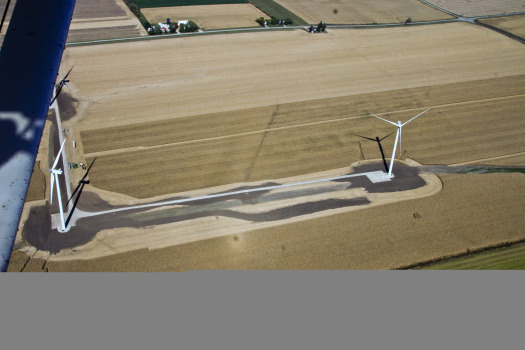
Michigan
THREE RECALLED IN JOYFIELD TOWNSHIP
TRAVERSE CITY — Voters have recalled three Joyfield Township officials they believe are too closely tied to a controversial wind project.
Supervisor Larry Lathwell, Clerk Gary Lathwell, and Treasurer Debra Lindgren have been recalled leaving just two members left on the board.
The trio signed leases with Duke Energy to have turbines placed on their property. and some residents say its a conflict of interest.
The Benzie County Election Commission, which is made up of the county’s clerk, probate judge, and treasurer will now chose an interim board member for the township. That will give them enough officials to vote for new members.
Whoever is chosen will serve until the next election in February 2012.
Continue reading...www.upnorthlive.com
Wind Turbine Opponents score victories in two township elections.
In Riga Township, residents voted 440 to 236 to uphold an ordinance that wind turbine supporters say effectively bans turbines in the township.
The vote means that the turbine ordinance enacted July 6 by the township board will stay in effect. That ordinance requires turbines to be no less than four times their own height from non-participating properties and also limits noise levels to 40 decibels between 10 p.m. and 6 a.m. and 45 decibels between 6 a.m. and 10 p.m.
In Ogden Township, the candidates backed by wind turbine opponents won the races for township supervisor and township clerk.
Continue reading... Daily Telegram
Maine:
Ban on large wind turbines approved in Brooksville:
BROOKSVILLE, Maine — Residents here voted overwhelmingly on Tuesday to approve a wind power ordinance that likely means the Hancock County town will be off-limits to commercial wind energy facilities....
Additionally, the ordinance adopts noise standards for wind turbines that are stricter than those currently required by the state. Turbines will be prohibited from generating in excess of 35 decibels for any continuous, 5-minute period — except during unusual weather events — as measured from neighboring properties. That standard is also more stringent than new, 42-decibel standards proposed by the Maine Board of Environmental Protection.
Continue reading... bangordailynews.com
Cushing approves new wind turbine ordinance
Cushing — Cushing residents voted Nov. 8 to enact a new town Wind Turbine Ordinance, limiting wind turbines to a maximum of 80 feet tall.
Residents supported the proposed ordinance by a vote of 273 to 181.
Under the ordinance wind turbines that meet the height requirement will be required to meet sound limits at the property lines. These limits will not support large commercial wind turbine installations.
Continue Reading.....Herald Gazette, knox.villagesoup.com
Rumford wind ordinance OK'd
RUMFORD — Third time’s a charm proved true Tuesday when a majority of voters overwhelmingly approved the third proposed wind ordinance in two years.
The tally was 1,137 “yes” to 465 “no,” Town Manager Carlo Puiia said. Fifty ballots were blank, meaning those voters didn’t select either answer.
The vote essentially kills any wind farms coming to Rumford until technology improves or the ordinance gets amended, he said.
Continue reading.....Sun Journal, www.sunjournal.com
New York State:
Hirschey defeats White in Cape Vincent; victory for anti-wind group
Regarding Mr. Hirschey’s plan to pass a moratorium on wind development to create a wind zoning law, Mr. White said that plan would “backfire” on the new town board because wind farm developers are likely to submit another application for the state to consider under the state-controlled Article X, essentially stripping Cape Vincent of home rule.
“I’m not upset,” said Mr. White, who as co-owner of White Farm holds contracts with both the St. Lawrence Wind Farm and the Cape Vincent Wind Farm projects. “I think the people of Cape Vincent will regret this later.”
Continue reading: watertowndailytimes.com
7/23/11 Ruthless, arrogant and destructive: Wind farm strong arm in Brown County AND cutting down trees and filling in wetlands in Vermont
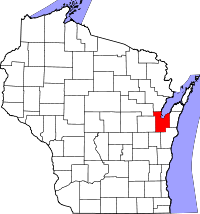
Glenmore Wind Energy Moratorium Challenged
Developer Appeals to Public Service Commission
By Matt Kapinos
(Denmark News: July 21 , 2011)
Michigan based CEnergy North America LLC has filed a request to open the docket with the Public Service Commission of Wisconsin (PSC) relating to a proposed 14.35 megawatt wind farm in the Town of Glenmore.
The request is, in effect, an appeal to the PSCW to overturn or override the moratorium on large wind development the Glenmore Town Board passed earlier this year.
Glenmore ordinance #046, passed by the newly elected Town Board at their May meeting reads, in part: "There is hereby established a temporary stay (moratorium) on the construction of large wind energy systems in the Town. During the temporary stay provided by this ordinance it shall be unlawful to install or construct any large wind energy systems or part thereof, and the Town shall not accept or process any application or issue any building permits relating to the proposed construction of any large wind energy system."
During the spring elections this year, Glenmore was notable in that it held a primary election to whittle down the pool of candidates for town supervisor positions. Most towns struggle to fill the ballot, and town supervisor positions in other municipalities often rely on write-in candidates to fill vacancies.
After the completion of the Shirley Wind Project late last year, and subsequent complaints from residents regarding health concerns and property values among other issues, wind turbines became the predominant issue in the election, and the sheer number of interested parties led to the primary.
The one year moratorium passed unanimously by the new board after notable opposition from citizens and organizations opposed to wind development in the town.
The request to open the docket, filed on behalf of CEnergy by their attorney, Elias Muawad of Bloomfield Hills, MI, seeks the PSCW's judgment as to "Whether or not the Township of Glenmore is wrongfully withholding the building permit which was granted to [CEnergy] by the Town of Glenmore at a Town Council meting."
You may recall the Glenmore board meeting in March of this year where the board voted to grant CEnergy the building permit. Soon after the vote was held, attendees began yelling and threatening some of the town's officials, necessitating the support of law enforcement. At that meeting, the board had voted to issue the permits, adjourned, then re-convened, potentially in deference of Wisconsin's open meetings law, and voted to rescind the permit and table the issue for sixty days pending the state's approval of the PSCW's Wind Siting Council recommendation for the siting of wind turbines. Within that sixty day reconsideration period, the new board took office and voted to put the one year moratorium in place.
The document alleges CEnergy received the town board's approval, and that they have met the requirements the board put in place at that March meeting. Specifically, the board asked for the necessary letter of credit (to provide for damages and dismantling of the installation later) on behalf of and in the name of the permit holder, and a hold harmless agreement to protect the town in case of a lawsuit against the developer. The document claims, "There was never any condition that in exchange for the Building Permit, that the name on the Letter of Credit should be in the name of [CEnergy]" although the minutes from the March board meeting clearly show that the board asked for that change. Either way, the document goes on to say CEnergy would willingly change the letter.
Additionally, the document goes on to state, "the moratorium is invalid because [CEnergy] was granted approval for the Conditional Use Permit and Building Permit prior to the moratorium being in effect" and that "there is no reasonable health, safety, or welfare issues granting the moratorium" --a claim that goes to the very heart of the issue in Glenmore.
Attorney Bob Gagan, legal counsel for the Town Board, made his limited comments regarding the situation to that effect, stating, "We disagree with the allegations stated in the Request to Open the Docket. The Town Board's goal is to protect the health and safety of the residents of the Town."
Gagan went on to say that the Board is awaiting new state standards for the siting of wind turbines, a process that has seemingly hit the skids since the state legislature's Joint Committee for Review of Administrative Rules declared the original recommendations of the Wind Siting Council "arbitrary and capricious." WPSC has yet to determine when or how it will proceed with determining new standards, and many local governments and wind developers have been in limbo ever since.
Muawad said in a phone interview with The Denmark News, "The Town granted the permit, and has since refused to issue it on paper. CEnergy has invested a lot of money in the project, well into the millions. We would rather find an amicable end to this situation, because CEnergy would like to maintain good relations with the neighbors of this facility. However, we are also pursuing legal action in the form of a civil suit. We are not going away."
From Vermont
WORK SUSPENDED ON LOWELL MOUNTAIN PROJECT
SOURCE: Vermont Public Radio News, www.vpr.net
July 22, 2011
By John Dillon
(Host) Green Mountain Power says work started on its Lowell Mountain wind project without state permission.
The work included filling in a wetland that was supposed to be protected to lessen the impact of the ridgeline development._
As VPR’s John Dillon reports, the Agency of Natural Resources is now investigating.
(Dillon) On a site visit to its proposed Lowell Mountain wind project, GMP said it had discovered that trees were cut down without permission. The company also saw that landowner Trip Wileman – who owns the ridge where the turbines will be built – had installed culverts and filled in part of a protected wetland.
Dorothy Schnure is a GMP spokeswoman.
(Schnure) “We have taken these errors very seriously. We have asked the contractors to leave the site. We have asked Mr. Wileman – and he’s agreed – not to access the portions of his land that are in the conservation easements. We want to make sure that nothing else happens that is not correct and appropriate and under permitted conditions.”
(Dillon) The wetland issue is a problem for GMP beyond the environmental impact.
GMP wants to build 21 turbines along the ridgeline. The construction will affect streams and upper elevation wetlands. The wetland that was damaged was supposed to be protected under a conservation easement to offset the impacts of the development
So the Agency of Natural Resources is now trying to determine the extent of the damage, and whether additional mitigation work will be needed. Deb Markowitz is ANR secretary.
(Markowitz) “So the first thing is we want to make sure the Public Service Board doesn’t approve any easements right now because our biologists are going up to walk on the land and our foresters are taking a look to see whether or not those changes affect those easements.”
(Dillon) Critics of the Lowell project say GMP violated the Clean Water Act by filling in the wetland. Annette Smith is executive director of Vermonters for a Clean Environment, which has questioned the environmental impact of large scale ridgeline wind projects.
(Smith) “The activities should be sent to enforcement, and those should be dealt with. And until a determination, the existing water quality permits that haven’t been issued should be put on hold.”
(Dillon) There are also questions whether the unauthorized construction will push back GMP’s time line for the Lowell project.
Jared Margolis is a lawyer who represents the towns of Albany and Craftsbury. He says the question now is whether the Public Service Board can approve GMP’s wetland mitigation plan. That approval is required prior to construction. And GMP wants to start construction August 1st.
(Margolis “Right now they don’t have a viable mitigation plan because what they were using for mitigation has been impacted itself. So that needs to be figured out prior to construction.”
(Dillon) GMP also needs a water quality permit from the state before it can start work. Several groups – including the Vermont Natural Resources Council – have challenged the permit, saying the project will damage upper elevation streams and cause erosion. GMP says the streams will be continuously monitored to assess water quality.
For VPR News, I’m John Dillon in Montpelier.
6/3/11 First comes the wind developer, then comes the met tower, then comes a lifetime of regret AND About that new wind developer poking around Spring Valley
 AN OPEN LETTER FROM A WISCONSIN FARMER WHO REGRETS SIGNING A WIND CONTRACT
AN OPEN LETTER FROM A WISCONSIN FARMER WHO REGRETS SIGNING A WIND CONTRACT
"By signing that contract, I signed away the control of the family farm, and it's the biggest regret I have ever experienced and will ever experience."
-Gary Steinich, Cambria, Wisconsin. June 2011
Sometime in late 2001 or early 2002, a wind developer working for Florida Power and Light showed up near the Wisconsin Town of Cambria looking to get in touch with someone at the Steinich family farm.
He wanted to talk to the landowner about leasing a bit of land for the installation of a met tower. He needed to measure the winds in the area for a possible windfarm and Walter Steinich's land looked like a good place to do it.
The wind developer seemed like a good guy to Mr. Steinich who was in his early 70's at the time. The money seemed good. A met tower didn't seem like a big deal. It was just a tall pole with some guy wires, and it was temporary. Mr. Steinich signed the contract.
That was nearly ten years ago. Mr. Steinich has since passed away and now his son, Gary, runs the farm. He's written an open letter to Wisconsin farmers about his experience with the wind company since then.
Photos below are of access roads and turbine foundations in various farm fields in the Glacier Hils project now under construction in Columbia County, Wisconsin
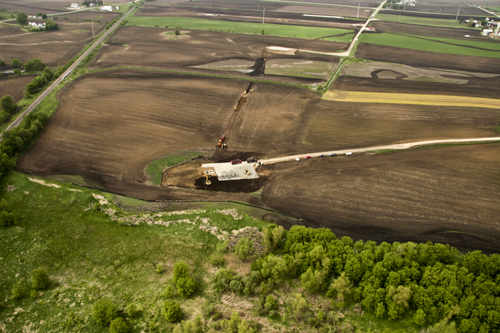 Turbine access road cutting diagonally across field in Glacier Hills project. May 2011
Turbine access road cutting diagonally across field in Glacier Hills project. May 2011
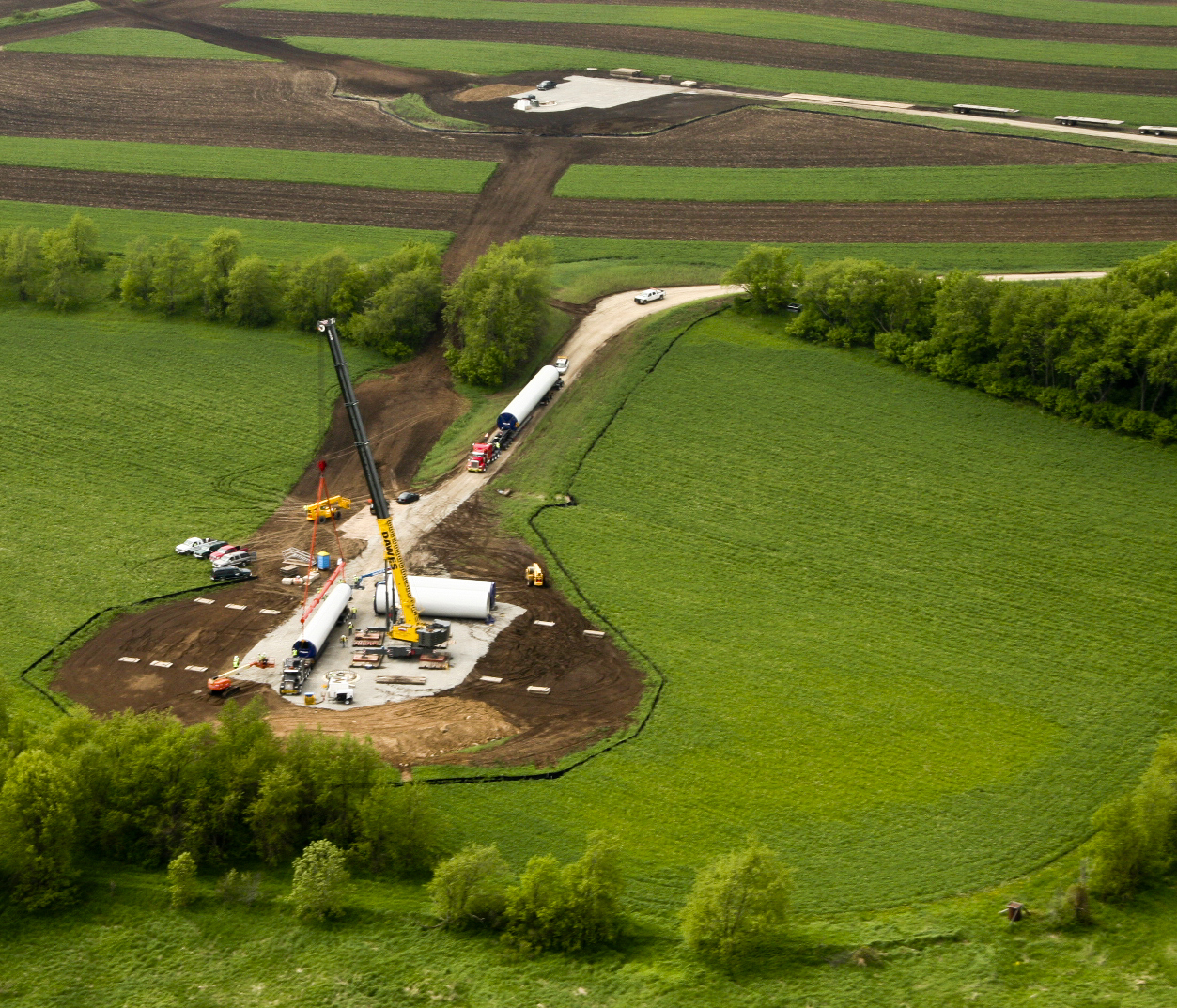
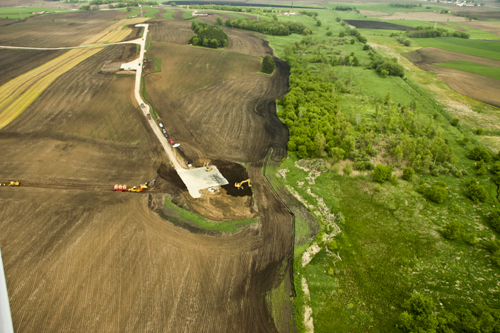
From One Wisconsin Farmer to Another:
This is an open letter to Wisconsin farmers who are considering signing a wind lease to host turbines on your land. Before you sign, I’d like to tell you about what happened to our family farm after we signed a contract with a wind developer.
In 2002, a wind developer approached my father about signing a lease agreement to place a MET tower on our land. My father was in his 70’s at the time. The developer did a good job of befriending him and gaining his trust.
He assured my father that the project wasn’t a done deal and was a long way off. They first had to put up the MET tower to measure the wind for awhile.
He told my father that if the project went forward there would be plenty of time to decide if we wanted to host turbines on our farm. There would be lots of details to work out and paperwork to sign well before the turbines would be built. The developer said my father could decide later on if he wanted to stay in the contract.
In 2003 the developer contacted us again. This time he wanted us to sign a contract to host turbines on our land. We were unsure about it, so we visited the closest wind project we knew of at the time. It was in Montfort, WI.
The Monfort project consists of 20 turbines that are about 300 feet tall and arranged in a straight line, taking up very little farmland with the turbine bases and access roads. The landowners seemed very satisfied with the turbines. But we were still unsure about making the commitment.
We were soon contacted again by the developer, and we told him we were undecided. Then he really started to put pressure on us to sign.
This was in March of 2004, a time of $1.60 corn and $1200 an acre land. It seemed worth it have to work around a couple of turbines for the extra cash. We were told the turbines would be in a straight line and only take up a little bit of land like the ones in Monfort.
And we were also told that we were the ones holding up the project. That all of our neighbors had signed, and we were the last hold-outs. It persuaded us.
What we didn’t know then was the developer was not being truthful. We were not the ‘last hold-out’ at all. In later discussions with our neighbors we found out that in fact we were the very first farmers to sign up. I have since found out this kind of falsehood is a common tactic of wind developers.
My father read through the contract. He said he thought it was ok. I briefly skimmed through it, found the language confusing, but trusted my father's judgment. We didn’t hire a lawyer to read it through with us. We didn’t feel the need to. The developer had explained what was in it.
The wind contract and easement on our farm was for 20 years. By then my dad was 75. He figured time was against him for dealing with this contract in the future so we agreed I should sign it. A few months later, my father died suddenly on Father's Day, June 20th, 2004
After that, we didn’t hear a whole lot about the wind farm for a couple years. There was talk that the project was dead. And then in 2007 we were told the developer sold the rights to the project. A Wisconsin utility bought it.
After that everything changed. The contract I signed had an option that allowed it to be extended for an additional 10 years. The utility used it.
The turbines planned for the project wouldn’t be like the ones in Monfort. They were going to be much larger, 400 feet tall. And there were going to be 90 of them.
They weren’t going to be in a straight row. They’d be sited in the spots the developer felt were best for his needs, including in middle of fields, with access roads sometimes cutting diagonally across good farm land. Landowners could have an opinion about turbine placement but they would not have final say as to where the turbines and access roads would be placed. It was all in the contract.
Nothing was the way we thought it was going to be. We didn't know how much land would be taken out of production by the access roads alone. And we didn't understand how much the wind company could do to our land because of what was in the contract..
In 2008 I had the first of many disputes with the utility, and soon realized that according to the contract I had little to no say about anything. This became painfully clear to me once the actual construction phase began in 2010 and the trucks and equipment came to our farm and started tearing up the field.
In October of 2010 a representative of the utility contacted me to ask if a pile of soil could be removed from my farm. It was near the base of one of the turbines they were putting on my land. I said no, that no soil is to be removed from my farm.
The rep said that the pile was actually my neighbor’s soil, that the company was storing it on my land with plans to move it to another property.
Shortly afterwards I noticed the pile of subsoil was gone.
In November of 2011 I saw several trucks loading up a second pile of soil on my land and watched them exiting down the road. I followed them and then called the Columbia County Sheriff. Reps from the company were called out. I wanted my soil back.
A few days later the rep admitted they couldn’t give it back to me because my soil was gone. It had been taken and already dispersed on someone else's land. I was offered 32 truck loads of soil from a stockpile they had. I was not guaranteed that the soil would be of the same quality and composition as the truck loads of soil they took from my farm.
I was informed by the lawyer for the utility that I had until April 30, 2011 to decide to take the soil. There would be no other offer. Take it or leave it.
I contacted the Public Service Commission for help. The PSC approved the terms of project and I believed the utility was violating those terms. The PSC responded by telling me they could do nothing because the issue involved a private contract between myself and the utility.
They told me my only option was to sue the utility.
My father and I both worked those fields. Watching the way they’ve been ripped apart would sicken any farmer. But what farmer has the time and money it would take to sue a Wisconsin utility?
By signing that contract I signed away the control of the family farm, and it’s the biggest regret I have ever experienced and will ever experience. I have only myself to blame for not paying close enough attention to what I was signing.
We had a peaceful community here before the developer showed up, but no more. Now it’s neighbor against neighbor, family members not speaking to one another and there is no ease in conversation like in the old days. Everyone is afraid to talk for fear the subject of the wind turbines will come up. The kind of life we enjoyed in our community is gone forever.
I spend a lot of sleepless nights wishing I could turn back the clock and apply what I've learned from this experience. Now corn and bean prices are up. The money from the turbines doesn't balance out our crop loss from land taken out of production. The kind of life we enjoyed on our family farm is gone forever too.
I would not sign that contract today. As I write this, the utility is putting up the towers all around us. In a few months the turbines will be turned on and we'll have noise and shadow flicker to deal with. If I have trouble with these things, too bad. I've signed away my right to complain. These are some of the many problems I knew nothing about when I signed onto the project.
If you are considering signing a wind lease, take the contract to a lawyer. Go over every detail. Find out exactly what can happen to your fields, find out all the developer will be allowed to do to your land. Go through that contract completely, and think hard before make your decision.
I can tell you from first hand experience, once you sign that contract, you will not have a chance to turn back.
Gary Steinich
Steinich Farms, Inc.
Cambria, WI
June, 2011
UPDATE: JUNE 5, 2011 Gary Steinich contacted Better Plan to let us know he and the utility have reached an agreement on his soil restoration.
EXTRA CREDIT READING:
It can be found on the PSC Docket for the Glacier HIlls project. [ #6634 CE 302]
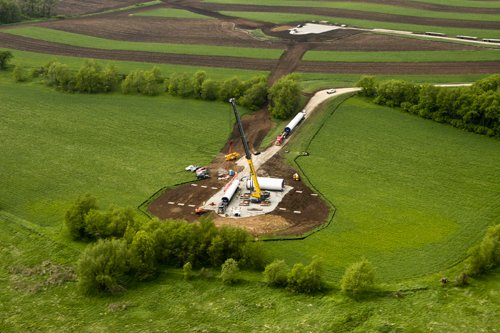
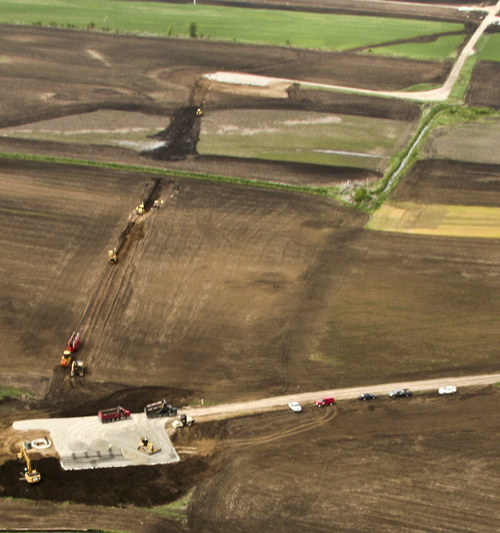
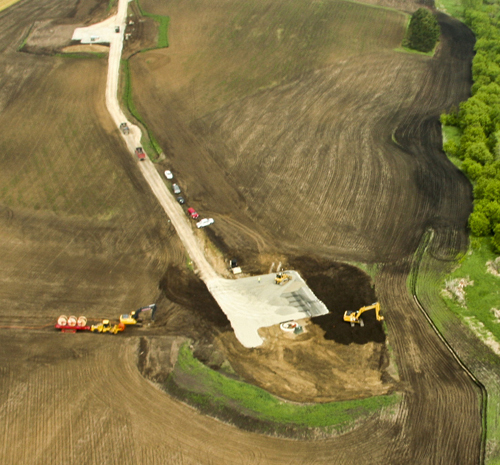
NEXT STORY: From Rock County, WI
SPRING VALLEY CONSIDERING BAN ON WIND TURBINES
SOURCE: The Janesville Gazette, gazettextra.com
June 4, 2011
By GINA DUWE
SPRING VALLEY TOWNSHIP — Town officials in Spring Valley are considering a new moratorium on wind turbines after the largest wind company in North America inquired about town wind ordinances.
The town board will discuss and likely vote on a moratorium at its Monday, June 13, meeting, Clerk Judy Albright said.
Spring Valley is among several area townships that wrote wind moratoriums while new rules to regulate wind projects less than 100-megawatts are decided at the state level.
Town officials discovered their previous moratorium expired Dec. 1 after Ted Weissman of NextEra Energy recently inquired about ordinances related to wind development and the process for placing a met tower.
A met tower gathers weather data to help wind developers determine if a site is good for development.
Weissman said he couldn’t comment but the company was looking at the area and hadn’t made any decisions. A company spokesman, however, said NextEra is not pursuing a met tower in Rock County.
Spokesman Steve Stengel said Weissman might have conducted some inquiries, but “we are not proposing it at this point,” he said. “What may or may not happen in the future (is) all speculation.”
NextEra owns and operates two wind farms in Wisconsin: 36 turbines at Butler Ridge Wind Energy Center in Dodge County and 20 turbines at Montfort Wind Energy Center in Iowa County.
Neighboring townships Magnolia and Union became possible sites for wind turbines a few years ago, and one met tower was placed in each town to gather data.
A spokeswoman for Acciona, the company that eyed those townships, said this week it is not pursuing “the early stage development project in Union and Magnolia. This enables (Acciona) to focus efforts and resources on other projects that are a better fit for their portfolio.”
Developers would be interested in hooking into the major transmission line that runs east-west through the northern part of Spring Valley, town officials said.
Smaller wind projects are permitted through local ordinances until lawmakers enact statewide rules.
Under state law, the Public Service Commission has to develop the rules, and a committee worked through most of last year to write the rules. When the rules were set to take effect in March, Republican lawmakers suspended them. It’s now up to legislators to approve new rules by May 2012 or the suspended rules would go into effect, a PSC spokesman said.
Republican Sen. Frank Lasee has proposed a bill that would add additional requirements to the PSC rules. The bill was referred to the Committee on Energy, Biotechnology and Consumer Protection, but no hearing is scheduled.
If you go
The town board will discuss and likely vote on a wind moratorium at its 7 p.m. meeting Monday, June 13, at the Orfordville Fire Department, 173 N. Wright St., Orfordville.
5/31/11 Wind Farm Strong Arm Chapter 4,358: From Ontario: Message to wind company AND Columbia county towers going up.
FROM ONTARIO
'GET OUT'
“You’re fighting a losing battle, just get out,” one resident shouted.
The company has received approval from the city to build eight turbines on the mountain range, after threatening a $126-million lawsuit when city officials in October rejected the location of several turbines.
Instead, community members lined up to voice their opposition to the project. Some told stories about what the mountain meant to them and others gave promises to stand against Horizon no matter what.
“You’re fighting a losing battle, just get out,” one resident shouted.
Jordan Morriseau, 30, usually hunts in the fall and said the turbines would impact his traditional hunting grounds and cause damage to endangered species that live on and around the mountain. He’s fighting against the project for environmental and cultural reasons, he said.
“That’s prime moose habitat up there,” Morriseau said. “We live off moose, it’s one of our main foods. The wind farm would be detrimental to our way of life.”
The company has received approval from the city to build eight turbines on the mountain range, after threatening a $126-million lawsuit when city officials in October rejected the location of several turbines. The project must still meet the standards set out by the province, through a renewable energy approval application. The province has already rejected Horizon’s REA application once.
Alex Legarde shared Morriseau’s concerns about the project. Legarde said he had questions he wanted answered, wondering if building the turbines would destroy hunting grounds. He’s concerned because hunting and trapping are his livelihood, he said.
Legarde hoped the project wouldn’t go through, he said.
Shane Wells, 31, went to the mic to speak a few times. He said he doesn’t know much about wind turbines, but he does know his community doesn’t want them and felt the two spokespersons for the company didn’t care what the community had to say.
“They could have put an audio recorder down and said see you all tomorrow and I`ll take that back to my boss,” Wells said. “I`ll give them the recorder of what was said. Oh they don’t like it, well just throw it away.”
Wyatt Bannon, one of organizers of the meeting, said he’s just one voice of many representing people who oppose the project. Horizon Wind is trying to build in an area that is sacred to the community and that development has to stop, he said.
No matter Horizon decides, the community is prepared to do to stop them, he said.
“We`ll do whatever it takes,” Bannon said. “We will not let it happen. Anybody to even consider putting those things up in such a pristine area are ignorant to everything people have worked. You don’t go into a watershed. That’s a no-brainer. It’s to protect the water. For these guys its money but for us it’s a lot more. It’s life.”
Following the meeting, officials with Horizon Wind weren’t available for comment.
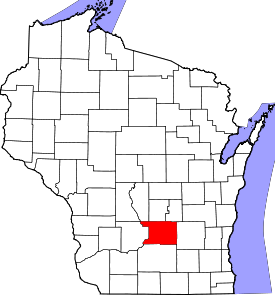
From Columbia County
WIND FARM TOWER SEGMENTS READY TO GO UP
May 31, 2011
By Lyn Jerde
“We’re building a project that not everybody wants in the community,”
TOWN OF SCOTT — How’s this for irony? The construction of the state’s largest wind energy facility is on hold, on account of wind.
The towers - the lower two components of them, anyway - were supposed to start piercing the skyline of northeastern Columbia County this week.
Instead, the components were, as of Thursday morning, lying on their sides, while the anemometers at the top of the cranes clocked wind speeds at about 40 mph. That’s about 15 mph too brisk for the safe construction of the towers.
It’s no surprise to Mike Strader of We Energies that breezes can get a tad gusty in these parts. That’s a key reason why We Energies is building the 90 turbine towers that will comprise Glacier Hills Wind Park on about farmland occupying about 17,300 acres in Columbia County’s towns of Randolph and Scott.
But, if the wind gusts to 25 mph or more, as it has all week, it’s not safe to erect the towers.
“What we can’t do is what we would love to do - put up those towers,” Strader said.
Starting Monday, plans had called for the arrival of the components of eight towers per day. The four segments of each tower would arrive, one at a time, from Manitowoc on trucks with about eight axles to distribute the weight evenly.
Many of the turbine blades have already arrived by rail from Colorado. Most are being stored, for now, on a town of Courtland parcel approved by Columbia County’s planning and zoning committee as a temporary staging area for the Glacier Hills project.
We Energies spokeswoman Cathy Schulze said that, for the most part, gawking at the construction will be discouraged, for the safety of the public and the workers, and because much of the technology is proprietary.
But the curiosity is understandable, she said, and an open house Wednesday is intended to satisfy that curiosity.
“A lot of people want to see these things,” she said. “This is a very good way let people get up close, without jeopardizing themselves and others.”
Strader said it had been hoped that at least the bottom two sections of a tower located near the construction office on Highway H, in the town of Scott, would have already been up by the time open house guests arrive Wednesday.
That doesn’t seem likely, given recent windy conditions, but it’s possible that people could see the components hoisted up Thursday.
Starting in the southeast quadrant of the construction area, Strader said, the base and “lower mid” segments of towers will be put up first.
The base component can be identified by a flange that sticks out around its bottom circumference. That’s the part that will be in contact with the ground, and held in place by grouting.
About six weeks after the bottom two segments of a tower go in, the top two segments will be installed. Also installed will be the nacelle (an enclosure at the top of each tower that contains the generator and transformer), the hub and the three blades.
The project is due to be finished in December, Strader said. He added that the wind delays so far have not put the project too far behind schedule - though there may be times when weather-delayed weekday work might have to be made up on Saturdays.
And yes, he said, some area people have let Glacier Hills construction workers know - sometimes by honked vehicle horns or shouts from vehicle windows - that they’re not happy about having 90 400-foot towers going up near where they live.
At the public hearings held before the Public Service Commission of Wisconsin authorized the project - with conditions - residents raised health-related concerns. Concerns include low-level noise and shadow flicker, as well as loss of TV reception, dangers to birds and bats and challenges for landing helicopter ambulances in the project’s vicinity.
“We’re building a project that not everybody wants in the community,” Strader said. “But, if alternative energy is to be produced in Wisconsin, then wind is one of the most viable resources.”
Want a closer look? Open house set Wednesday
The public is invited to take a closer look Wednesday at the construction of Glacier Hills Wind Park - including the big components of the 90 wind turbine towers that are going up in the towns of Scott and Randolph.
We Energies will have an open house from 3 to 7 p.m. Wednesday at the Glacier Hills construction office, N7844 Highway H, about a half-mile south of Highway 33 in the town of Scott.
In addition to viewing components and construction equipment, participants may sign their names to a turbine blade.
Officials of We Energies will be there to answer questions about the Glacier Hills project.
By the numbers
14: The approximate diameter, in feet, of the hollow space inside one of the Glacier Hills Wind Park towers, where there’s a ladder by which maintenance workers can access the towers.
138: The weight, in tons, of each completed tower.
148: The length, in feet, of each of the three turbine blades on each tower.
410: The height, in feet, from the ground to the top of the highest-reaching blade.
3: The number of quality checks that each turbine must pass before it’s operational. The turbines also will be inspected for safety periodically once they start generating electricity.
4: The number of sections in each tower.
56: The number of miles of underground trenching for the electrical distribution system within Glacier Hills. A lot of that is along Highway 33 just west of Cambria.
8: The number of axles on a truck that hauls a single segment of a turbine tower.
100 to 105: The number of feet high that the bottom two components of a tower - the base and the “lower mid” - stand once they’re assembled.
2: The number of towers per day that We Energies had hoped to build, starting Monday.
0: The number of towers that have been built as of Thursday.


